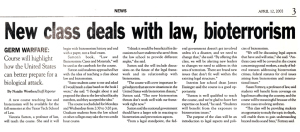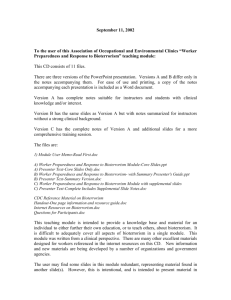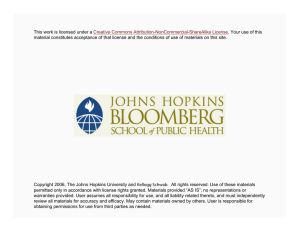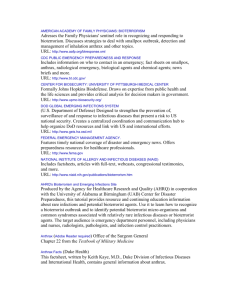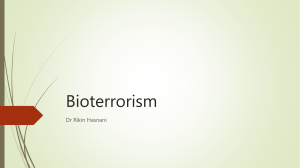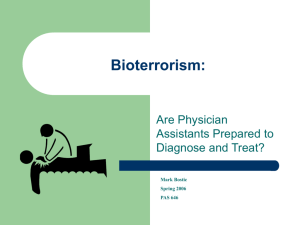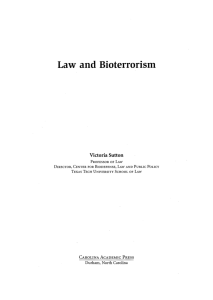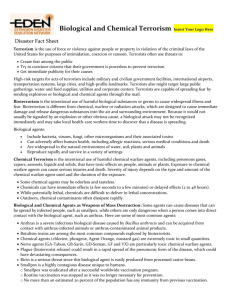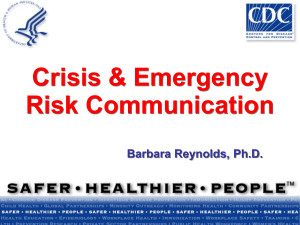Word file
advertisement
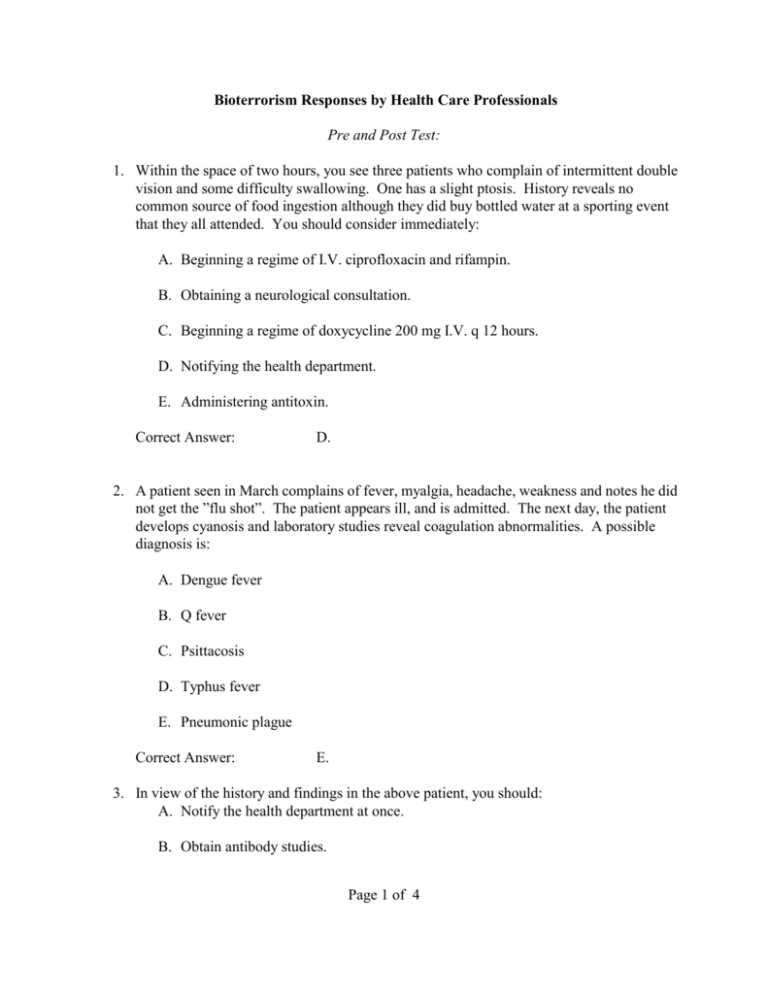
Bioterrorism Responses by Health Care Professionals Pre and Post Test: 1. Within the space of two hours, you see three patients who complain of intermittent double vision and some difficulty swallowing. One has a slight ptosis. History reveals no common source of food ingestion although they did buy bottled water at a sporting event that they all attended. You should consider immediately: A. Beginning a regime of I.V. ciprofloxacin and rifampin. B. Obtaining a neurological consultation. C. Beginning a regime of doxycycline 200 mg I.V. q 12 hours. D. Notifying the health department. E. Administering antitoxin. Correct Answer: D. 2. A patient seen in March complains of fever, myalgia, headache, weakness and notes he did not get the ”flu shot”. The patient appears ill, and is admitted. The next day, the patient develops cyanosis and laboratory studies reveal coagulation abnormalities. A possible diagnosis is: A. Dengue fever B. Q fever C. Psittacosis D. Typhus fever E. Pneumonic plague Correct Answer: E. 3. In view of the history and findings in the above patient, you should: A. Notify the health department at once. B. Obtain antibody studies. Page 1 of 4 C. Obtain blood and sputum cultures. D. Do a gram stain on peripheral blood. E. Begin an I.V. regime of ciprofloxacin and rifampin. Correct Answer: A 4. Bioterrorism agents in CDC’s Category A agents have the potential for major public heath impact. An additional essential characteristic of such agents is that they: A. Be able to be confirmed by laboratory studies at major medical centers. B. Be easily disseminated or transmitted from person to person. C. Have an untreated mortality rate of at least 50%. D. Have antibiotic, vaccine, or other therapeutic modality that will reduce the mortality rate. E. Require specific enhancement of CDC’s diagnostic capabilities. Correct Answer: B 5. Large scale and “table-top” bioterrorism exercises have clearly demonstrated the critical importance of: A. Planning for use of the National Pharmaceutical Stockpile. B. Planning for use of near-by military health care organizations. C. Assuring cell-phones are available in sufficient number since telephone circuits are rapidly overloaded during an event. D. Defining who is in charge and who replacements are. E. Obtaining forensic information and samples to help identify the perpetrators. Correct Answer: D Page 2 of 4 6. You see four patients for “allergies” during a clinic day in the late spring when pollen counts are unusually high. Your history reveals all four work in a government office that has recently had work done on the ventilation system because it was not working properly. Your examination reveals periorbital edema in two patients. Three have mucous membrane bleeding, but all noted marked sneezing the past few days. One patient has a few petechiae. Your next step is to: A. Contact the work site to determine whether the ventilation system has been properly prepared. B. Contact the work site to determine whether any environmental samples have been taken, and, if so, the results. C. Begin a course of antihistamine to determine if symptoms are likely due to allergies. D. Notify the health department at once. E. Begin a course of ciprofloxacin, rifampin, and clindamycin. Correct Answer: D 7. Those planning for health care facility response to a bioterrorism event must plan for: A. Stockpiling sufficient vaccine for Category A agents for at least 2 weeks for projected numbers of patients. B. Stockpiling sufficient antibiotics for Category A agents for at least 2 weeks for projected numbers of patients. C. Stockpiling sufficient vaccines and/or antibiotics for Category A agents for at least 2 weeks for projected numbers of patients. D. Immunizations of staff and other medical facility workers to Category A agents. E. Rotation and relief of staff and other medical facility workers. Correct Answer: E 8. Prior to notifying a public health agency of the occurrence of a tularaemia patient, you must: A. Obtain confirmation via fluorescence antibody testing. B. Have made a clinical diagnosis or suspect the condition. Page 3 of 4 C. Obtain confirmation via serum antibody studies. D. Have obtained information on any recent travels by the patient outside the U.S. E. Cultured sputum and, if possible, bronchial washings. Correct Answer: B. 9. A major recent concern with respect to bioterrorism is: A. Possible loss of control of some agents during the dissolution of the Union of Soviet Socialist Republics. B. Inability to develop sensors that will detect agents on a “real time” basis. C. Potential development of biological agents by commercial organizations and sale of such agents to terrorists. D. The national cost of developing effective bioterrorism defenses. E. The potential for state or national quarantines. Correct answer: A 10. Which of the following is not a CDC Category A agent? A. Bacillus anthracis B. Clostridium botulinum toxin C. Rickettsia prowazekii D. Francisella tularensis E. Yersinia pestis Correct Answer: C Page 4 of 4
